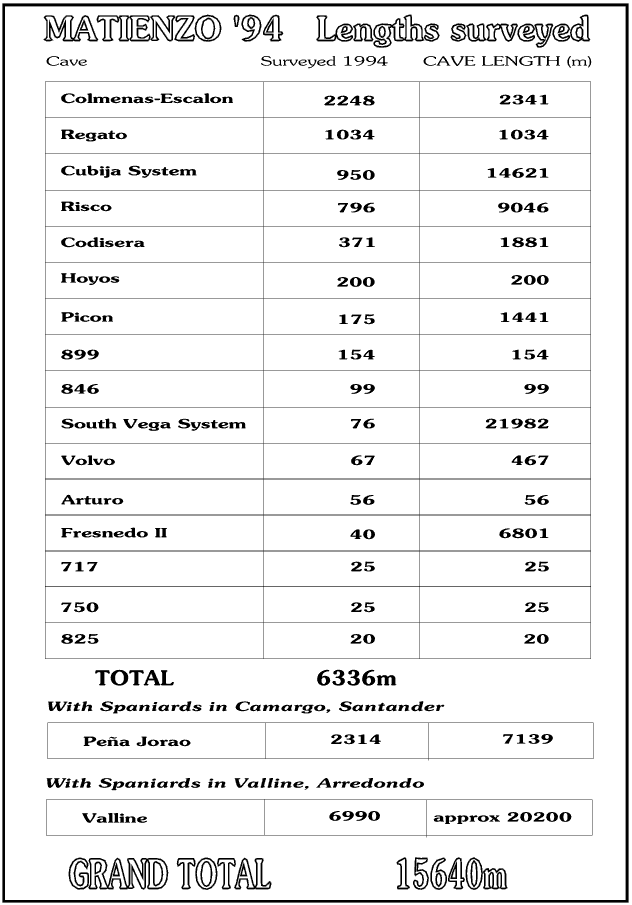Matienzo 1994
Explorations in the caves around Matienzo during 1994
amended from an article by Juan Corrin in Caves & Caving 66
The discoveries were over-shadowed by the tragic loss of Alan Box in La Hoyuca (Cueva Uzueka).
Alan had been to Matienzo a number of times. On this occasion he was involved in successfully bolting and maypoling the 100m high Astradome into new passage. The expedition surveyed over 6.3km in our area and, by invitation in joint Spanish / English teams, extensions in Cueva Valline and 2.2km in Peña Jorao.
The Four Valleys System
During 1993 the main thrust of exploration in the 40.6km long Four Valleys System was
up the Astradome, a 30m diameter, 100m high aven, about 4.5km into La Hoyuca (site 107).
It was to overcome poor bolting rock discovered 90m up during the previous year that Mark
Wright and Alan Box took in a 6m aluminium sectional pole. This was erected from a bolt
above the sandstone into the hole at the top of the aven. While returning from pushing
above the aven, Alan fell 90m from a tail of rope. The recovery lasted 11 hours and
involved 12 British and 11 Spanish cavers.
Cueva de Bollón (98) was dived by Rob Murgatroyd and Toby Chilton to find 50m of passage and another sump. The potential is excellent with the end of the Western Series in Carcavueso (81) lurking a hundred metres away and virtually virgin limestone to the west, although Regaton (892) lies 1.5km in this direction.
El Sistema de Cubija
In 1985 a pitch at the end of Hedgehog Crawl in Cueva Mostajo (71) was descended 40m
by visiting Italian cavers and became too tight. Nine years later, after finds in
Cubio-Regaton came very close, the Italian pitch was re-descended and the question mark
became the link with Cubio-Regaton. Another 400m was surveyed at the end of Hedgehog
Crawl. The combined Cubija System of El Cubio (243), Torca de Regaton and Torca de Mostajo
now has a length of 14.2km. Further work should see other caves linked and a 20km system
proved.
Beneath the Cubija valley, on the north side of La Vega, Fuente el Escalón (280) was
explored and joined to another nearby resurgence through 2.34km of small passage over a
70m vertical range.
Ozana
The 8.3km in Risco (25) cave is highly linear and, although it lies under the edge of
the Muela and Mullir, there is no known passage coming in from those hills. This year a
bolt climb and traverse above the chasm at the southern end of the Arco Gallery found
cavers ascending through a precarious boulder pile into a top level 50 - 60m above the
stream. The passages discovered lie beyond and over the Arco Gallery on the same line and
contain some impressive crystals and formations. One formation was described as a 1m high,
single-crystal, triangular stalagmite, possibly re-crystallized and certainly rare. Nearly
800m were surveyed with a possible bolt climb still to go at, although there is still no
sign of water or passage from Mullir.
South Vega
The main pitch in Codisera (39) was crossed over to the east and a single shaft
descended 90m to a floor of boulders with a soak-away. Part way down this pitch a major
level was entered to the north but this choked with boulders after 80m. The continuation
on the southern side of the wide shaft was bolted into and 230m of large, new passage
entered. Unfortunately this tunnel and the higher level heading south both appear to choke
under the head of a large, enclosed valley, near a point molephoned and GPS'd this summer.
Camargo
Speleological activities carried out jointly with the Spanish GEIC/R group have
occurred in Peña Jorao over a number of years. The system lies a short drive from
Santander and takes water from a major sink and probably others within an area of
archaeological importance. The site was extended by 2.3km to 7.14km.
Giles Barker
Giles Barker died in the South Vega System during the 1992 expedition. At the
suggestion of a local councillor the district council placed a plaque at the bottom
entrance to the cave. A dedication ceremony with short speeches took place on Sunday, 14th
August and was attended by members of this year's expedition and more than sixty
villagers, including the Mayor and councillors. In all, well over one hundred people were
present.

Recent References
Matienzo '93 in Caves & Caving 63, Spring 1994;
Matienzo '92 in Caves & Caving 58, Winter 1992